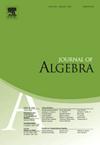全等正三角形和全等菱形对球面的镶嵌
IF 0.8
2区 数学
Q2 MATHEMATICS
引用次数: 0
摘要
所有由全等正三角形和全等菱形构成的球面边缘到边缘的平铺被分类为:(1)一个1参数族的原集,每个原集都有一个唯一的(2a3,3a4)平铺,就像一个三角形棱镜;(2)一个单参数原集族,每个原集分别具有2种不同的(8a3,6a4)平铺,如立方体和三角形正二面体;(3)对于每一个n≥3的原集合序列,每个原集合具有一个唯一的(2a3,(6n−3)a4)-平铺,就像一个广义反三角棱镜;(4)零星原集26个,其中有1种独特的原集19个,2种不同的原集3个,3种不同的原集1个,5种不同的原集1个,数不清的原集2个(这种多态现象在总数少的单面体球面原集中是看不到的)。给出了参数化平铺的模和所有几何数据。本文章由计算机程序翻译,如有差异,请以英文原文为准。
Tilings of the sphere by congruent regular triangles and congruent rhombi
Abstract All edge-to-edge tilings of the sphere by congruent regular triangles and congruent rhombi are classified as: (1) a 1-parameter family of protosets each admitting a unique -tiling like a triangular prism; (2) a 1-parameter family of protosets each admitting 2 different -tilings like a cuboctahedron and a triangular orthobicupola respectively; (3) a sequence of protosets each admitting a unique -tiling like a generalized anti-triangular prism for each ; (4) 26 sporadic protosets, among which nineteen admit a unique tiling, three admit 2 different tilings, one admits 3 different tilings, one admits 5 different tilings, two admit too many tilings to count (such polymorphic phenomena is unseen in monohedral spherical tilings with small total number of tiles). The moduli of parameterized tilings and all geometric data are provided.
求助全文
通过发布文献求助,成功后即可免费获取论文全文。
去求助
来源期刊

Journal of Algebra
数学-数学
CiteScore
1.50
自引率
22.20%
发文量
414
审稿时长
2-4 weeks
期刊介绍:
The Journal of Algebra is a leading international journal and publishes papers that demonstrate high quality research results in algebra and related computational aspects. Only the very best and most interesting papers are to be considered for publication in the journal. With this in mind, it is important that the contribution offer a substantial result that will have a lasting effect upon the field. The journal also seeks work that presents innovative techniques that offer promising results for future research.
 求助内容:
求助内容: 应助结果提醒方式:
应助结果提醒方式:


